MBA641 Strategic Project Management: Project Feasibility and Timeline
VerifiedAdded on 2023/06/07
|10
|2615
|91
Report
AI Summary
This report presents a detailed feasibility study and timeline analysis for a residential duplex development project in La Trobe Street, Melbourne. It evaluates the project's economic viability, considering factors like stamp duty, conveyancing fees, land size, council rates, rental income, and agent fees. The study includes a feasibility table summarizing purchase, council, construction, and duplex information, along with project results. Major constraints such as scope, time, and cost are discussed, alongside the project's goal. A macro-environment analysis examines economic, socio-cultural, resourcing, and demographic factors, while a micro-environment analysis focuses on time pressures, stakeholders, technical expertise, marketing, and suppliers. The report concludes by emphasizing the importance of feasibility, timeline, and environmental management for project success, referencing various academic sources.
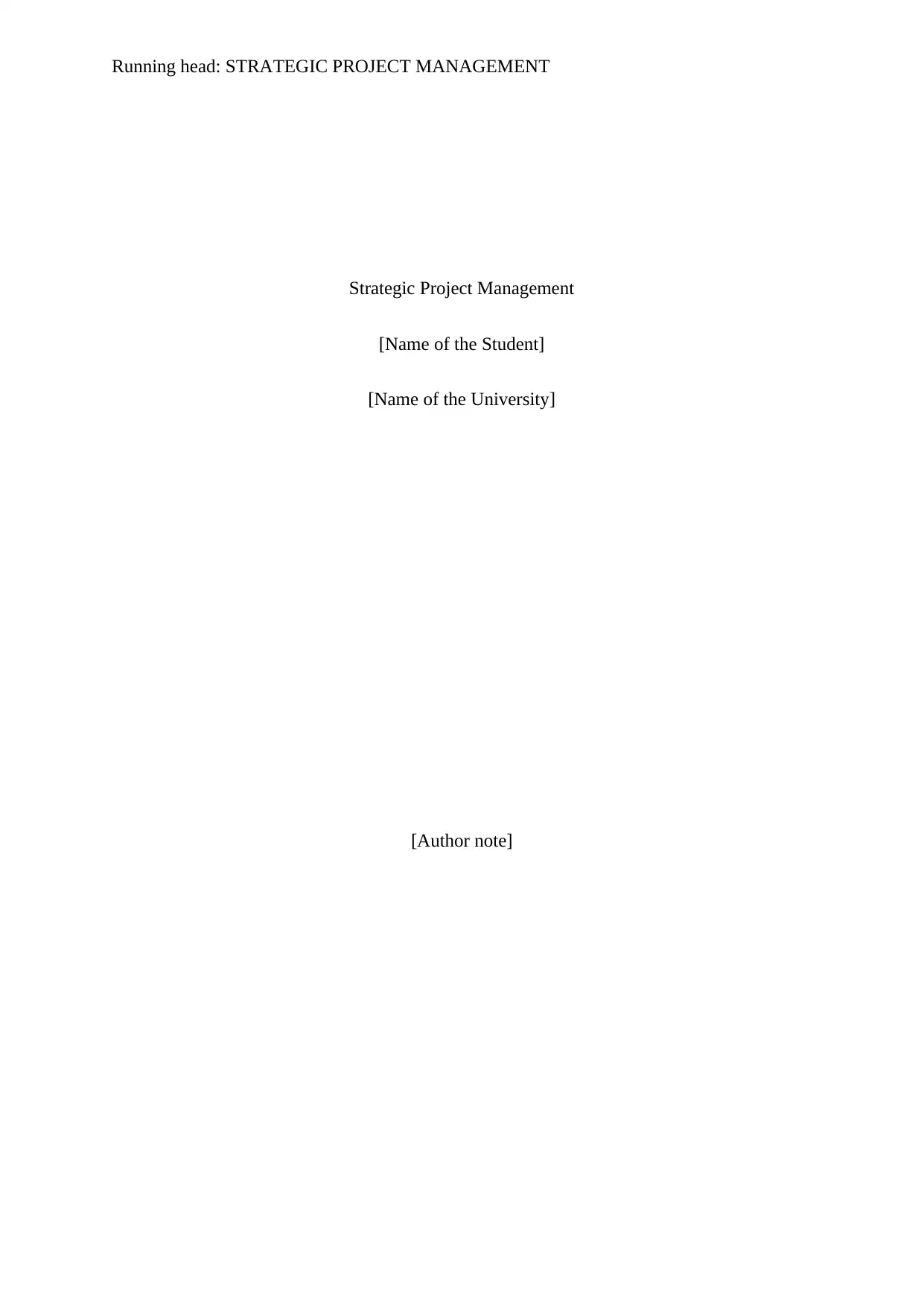
Running head: STRATEGIC PROJECT MANAGEMENT
Strategic Project Management
[Name of the Student]
[Name of the University]
[Author note]
Strategic Project Management
[Name of the Student]
[Name of the University]
[Author note]
Paraphrase This Document
Need a fresh take? Get an instant paraphrase of this document with our AI Paraphraser
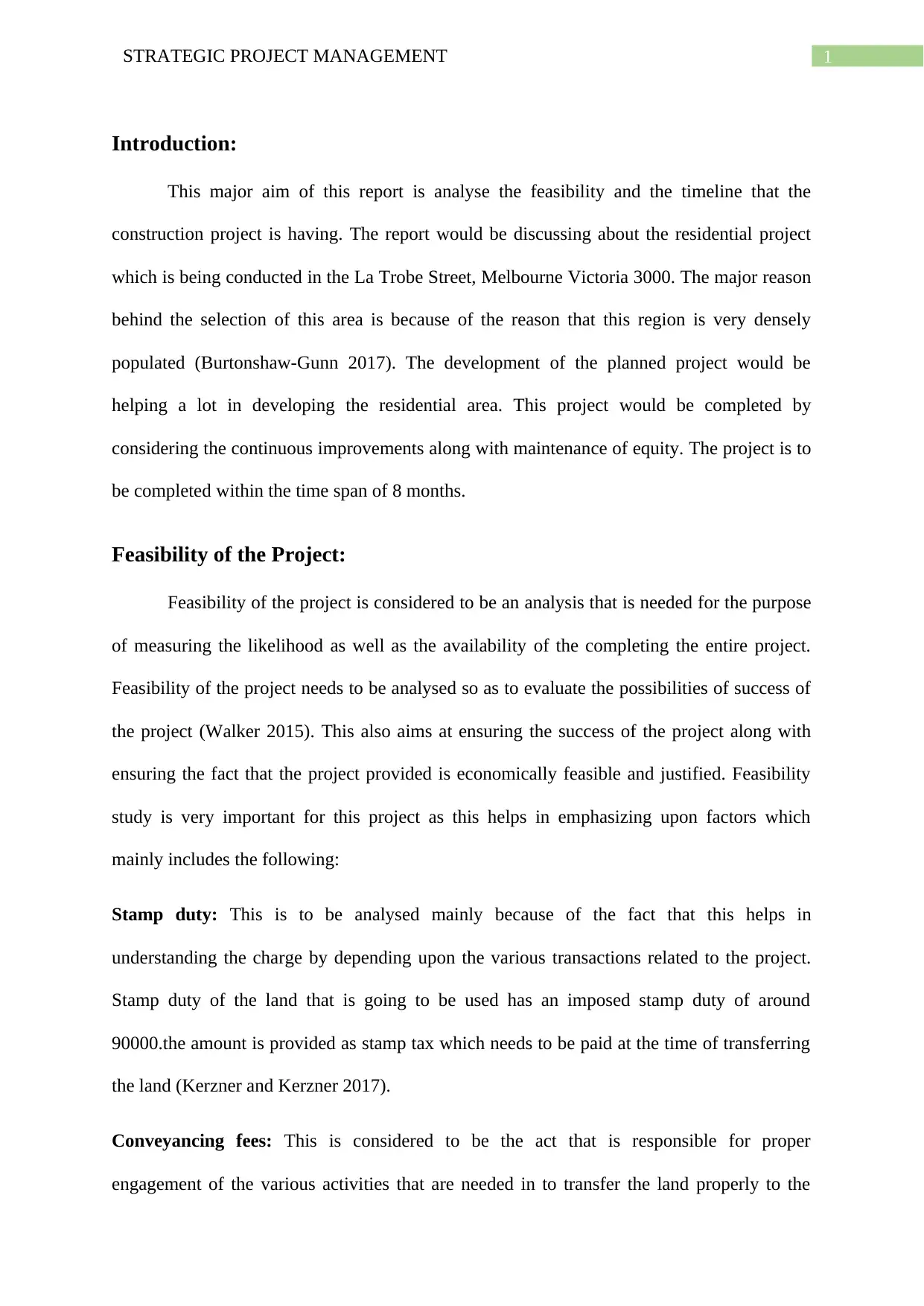
1STRATEGIC PROJECT MANAGEMENT
Introduction:
This major aim of this report is analyse the feasibility and the timeline that the
construction project is having. The report would be discussing about the residential project
which is being conducted in the La Trobe Street, Melbourne Victoria 3000. The major reason
behind the selection of this area is because of the reason that this region is very densely
populated (Burtonshaw-Gunn 2017). The development of the planned project would be
helping a lot in developing the residential area. This project would be completed by
considering the continuous improvements along with maintenance of equity. The project is to
be completed within the time span of 8 months.
Feasibility of the Project:
Feasibility of the project is considered to be an analysis that is needed for the purpose
of measuring the likelihood as well as the availability of the completing the entire project.
Feasibility of the project needs to be analysed so as to evaluate the possibilities of success of
the project (Walker 2015). This also aims at ensuring the success of the project along with
ensuring the fact that the project provided is economically feasible and justified. Feasibility
study is very important for this project as this helps in emphasizing upon factors which
mainly includes the following:
Stamp duty: This is to be analysed mainly because of the fact that this helps in
understanding the charge by depending upon the various transactions related to the project.
Stamp duty of the land that is going to be used has an imposed stamp duty of around
90000.the amount is provided as stamp tax which needs to be paid at the time of transferring
the land (Kerzner and Kerzner 2017).
Conveyancing fees: This is considered to be the act that is responsible for proper
engagement of the various activities that are needed in to transfer the land properly to the
Introduction:
This major aim of this report is analyse the feasibility and the timeline that the
construction project is having. The report would be discussing about the residential project
which is being conducted in the La Trobe Street, Melbourne Victoria 3000. The major reason
behind the selection of this area is because of the reason that this region is very densely
populated (Burtonshaw-Gunn 2017). The development of the planned project would be
helping a lot in developing the residential area. This project would be completed by
considering the continuous improvements along with maintenance of equity. The project is to
be completed within the time span of 8 months.
Feasibility of the Project:
Feasibility of the project is considered to be an analysis that is needed for the purpose
of measuring the likelihood as well as the availability of the completing the entire project.
Feasibility of the project needs to be analysed so as to evaluate the possibilities of success of
the project (Walker 2015). This also aims at ensuring the success of the project along with
ensuring the fact that the project provided is economically feasible and justified. Feasibility
study is very important for this project as this helps in emphasizing upon factors which
mainly includes the following:
Stamp duty: This is to be analysed mainly because of the fact that this helps in
understanding the charge by depending upon the various transactions related to the project.
Stamp duty of the land that is going to be used has an imposed stamp duty of around
90000.the amount is provided as stamp tax which needs to be paid at the time of transferring
the land (Kerzner and Kerzner 2017).
Conveyancing fees: This is considered to be the act that is responsible for proper
engagement of the various activities that are needed in to transfer the land properly to the
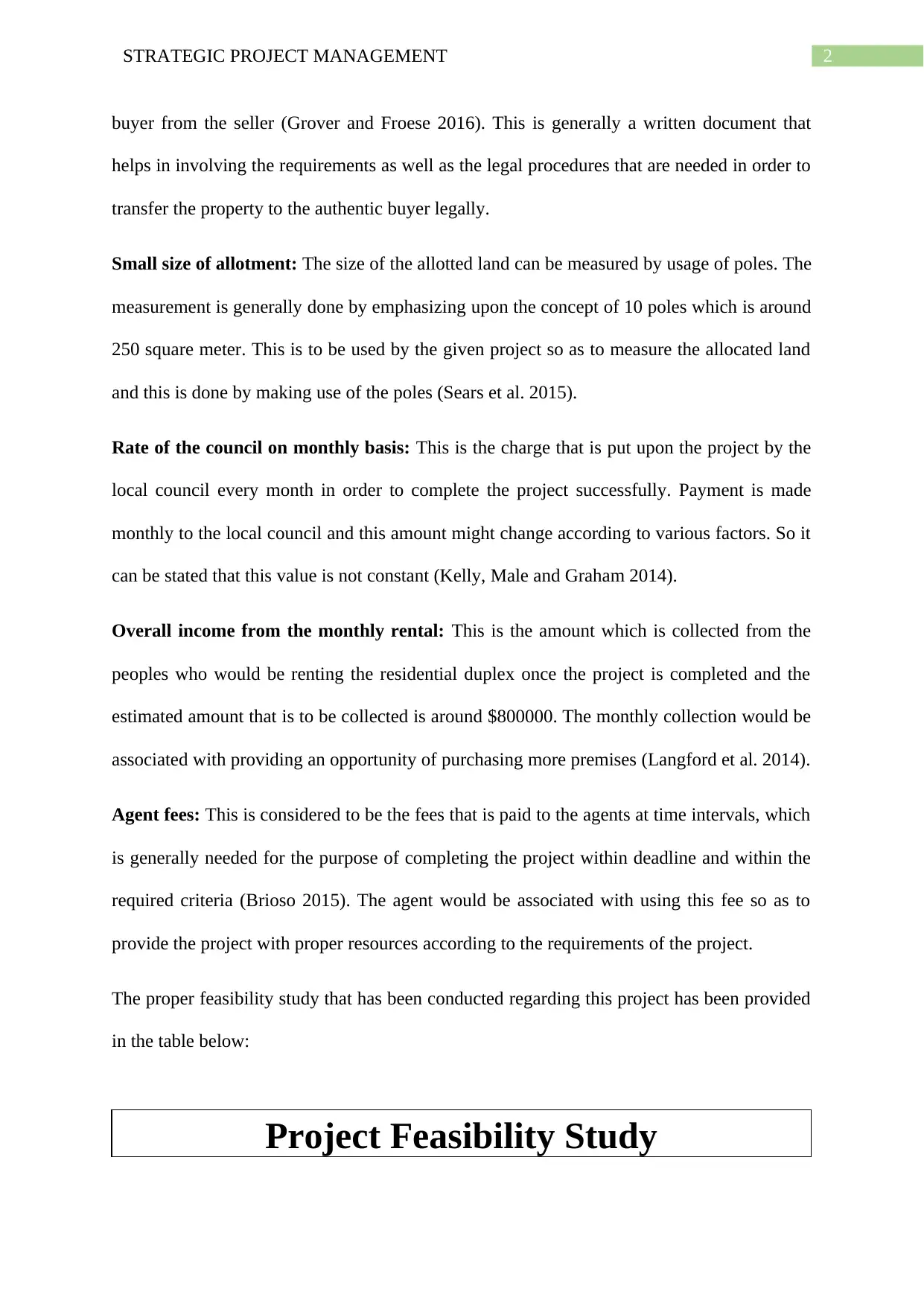
2STRATEGIC PROJECT MANAGEMENT
buyer from the seller (Grover and Froese 2016). This is generally a written document that
helps in involving the requirements as well as the legal procedures that are needed in order to
transfer the property to the authentic buyer legally.
Small size of allotment: The size of the allotted land can be measured by usage of poles. The
measurement is generally done by emphasizing upon the concept of 10 poles which is around
250 square meter. This is to be used by the given project so as to measure the allocated land
and this is done by making use of the poles (Sears et al. 2015).
Rate of the council on monthly basis: This is the charge that is put upon the project by the
local council every month in order to complete the project successfully. Payment is made
monthly to the local council and this amount might change according to various factors. So it
can be stated that this value is not constant (Kelly, Male and Graham 2014).
Overall income from the monthly rental: This is the amount which is collected from the
peoples who would be renting the residential duplex once the project is completed and the
estimated amount that is to be collected is around $800000. The monthly collection would be
associated with providing an opportunity of purchasing more premises (Langford et al. 2014).
Agent fees: This is considered to be the fees that is paid to the agents at time intervals, which
is generally needed for the purpose of completing the project within deadline and within the
required criteria (Brioso 2015). The agent would be associated with using this fee so as to
provide the project with proper resources according to the requirements of the project.
The proper feasibility study that has been conducted regarding this project has been provided
in the table below:
Project Feasibility Study
buyer from the seller (Grover and Froese 2016). This is generally a written document that
helps in involving the requirements as well as the legal procedures that are needed in order to
transfer the property to the authentic buyer legally.
Small size of allotment: The size of the allotted land can be measured by usage of poles. The
measurement is generally done by emphasizing upon the concept of 10 poles which is around
250 square meter. This is to be used by the given project so as to measure the allocated land
and this is done by making use of the poles (Sears et al. 2015).
Rate of the council on monthly basis: This is the charge that is put upon the project by the
local council every month in order to complete the project successfully. Payment is made
monthly to the local council and this amount might change according to various factors. So it
can be stated that this value is not constant (Kelly, Male and Graham 2014).
Overall income from the monthly rental: This is the amount which is collected from the
peoples who would be renting the residential duplex once the project is completed and the
estimated amount that is to be collected is around $800000. The monthly collection would be
associated with providing an opportunity of purchasing more premises (Langford et al. 2014).
Agent fees: This is considered to be the fees that is paid to the agents at time intervals, which
is generally needed for the purpose of completing the project within deadline and within the
required criteria (Brioso 2015). The agent would be associated with using this fee so as to
provide the project with proper resources according to the requirements of the project.
The proper feasibility study that has been conducted regarding this project has been provided
in the table below:
Project Feasibility Study
⊘ This is a preview!⊘
Do you want full access?
Subscribe today to unlock all pages.

Trusted by 1+ million students worldwide
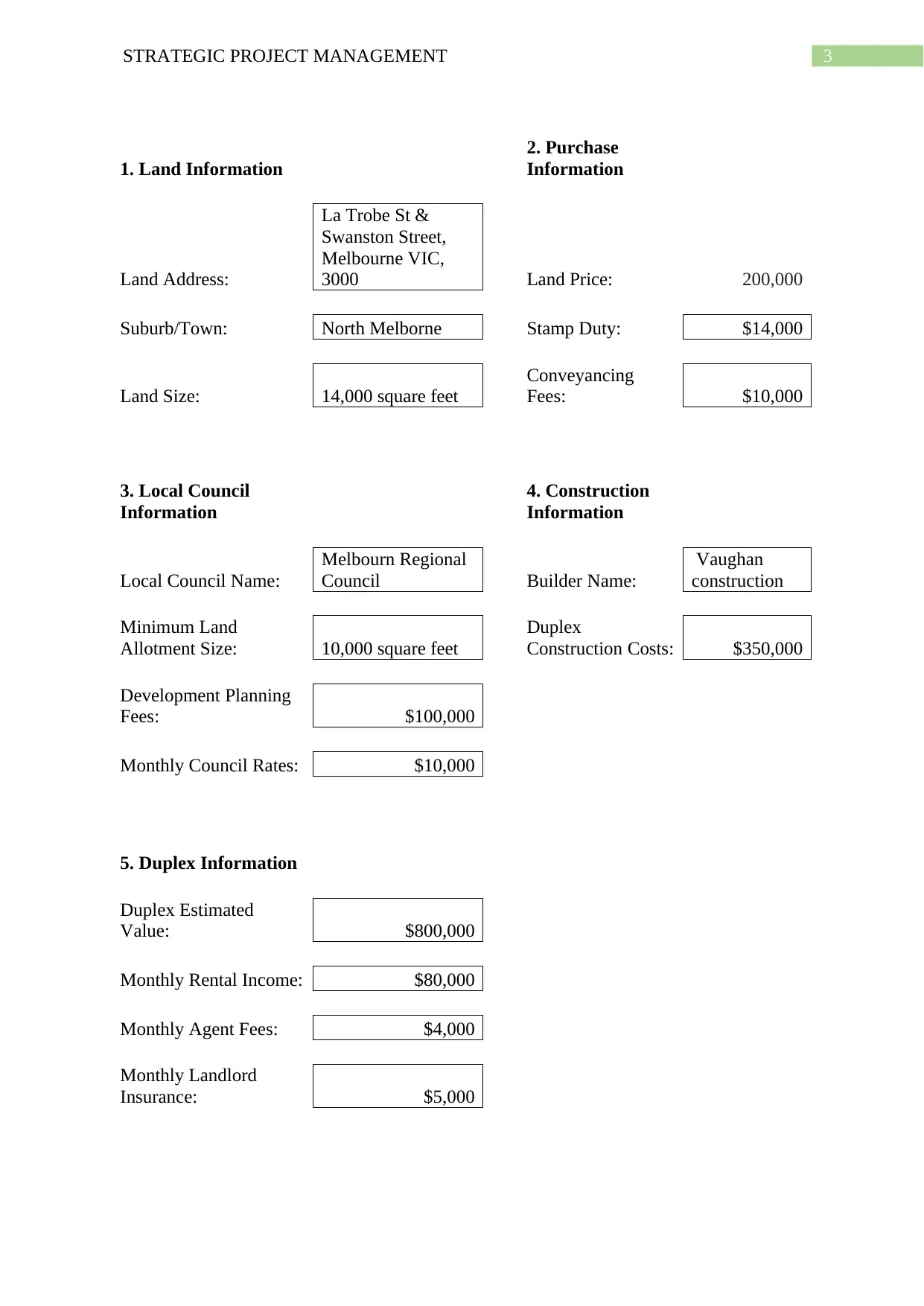
3STRATEGIC PROJECT MANAGEMENT
1. Land Information
2. Purchase
Information
Land Address:
La Trobe St &
Swanston Street,
Melbourne VIC,
3000 Land Price: 200,000
Suburb/Town: North Melborne Stamp Duty: $14,000
Land Size: 14,000 square feet
Conveyancing
Fees: $10,000
3. Local Council
Information
4. Construction
Information
Local Council Name:
Melbourn Regional
Council Builder Name:
Vaughan
construction
Minimum Land
Allotment Size: 10,000 square feet
Duplex
Construction Costs: $350,000
Development Planning
Fees: $100,000
Monthly Council Rates: $10,000
5. Duplex Information
Duplex Estimated
Value: $800,000
Monthly Rental Income: $80,000
Monthly Agent Fees: $4,000
Monthly Landlord
Insurance: $5,000
1. Land Information
2. Purchase
Information
Land Address:
La Trobe St &
Swanston Street,
Melbourne VIC,
3000 Land Price: 200,000
Suburb/Town: North Melborne Stamp Duty: $14,000
Land Size: 14,000 square feet
Conveyancing
Fees: $10,000
3. Local Council
Information
4. Construction
Information
Local Council Name:
Melbourn Regional
Council Builder Name:
Vaughan
construction
Minimum Land
Allotment Size: 10,000 square feet
Duplex
Construction Costs: $350,000
Development Planning
Fees: $100,000
Monthly Council Rates: $10,000
5. Duplex Information
Duplex Estimated
Value: $800,000
Monthly Rental Income: $80,000
Monthly Agent Fees: $4,000
Monthly Landlord
Insurance: $5,000
Paraphrase This Document
Need a fresh take? Get an instant paraphrase of this document with our AI Paraphraser
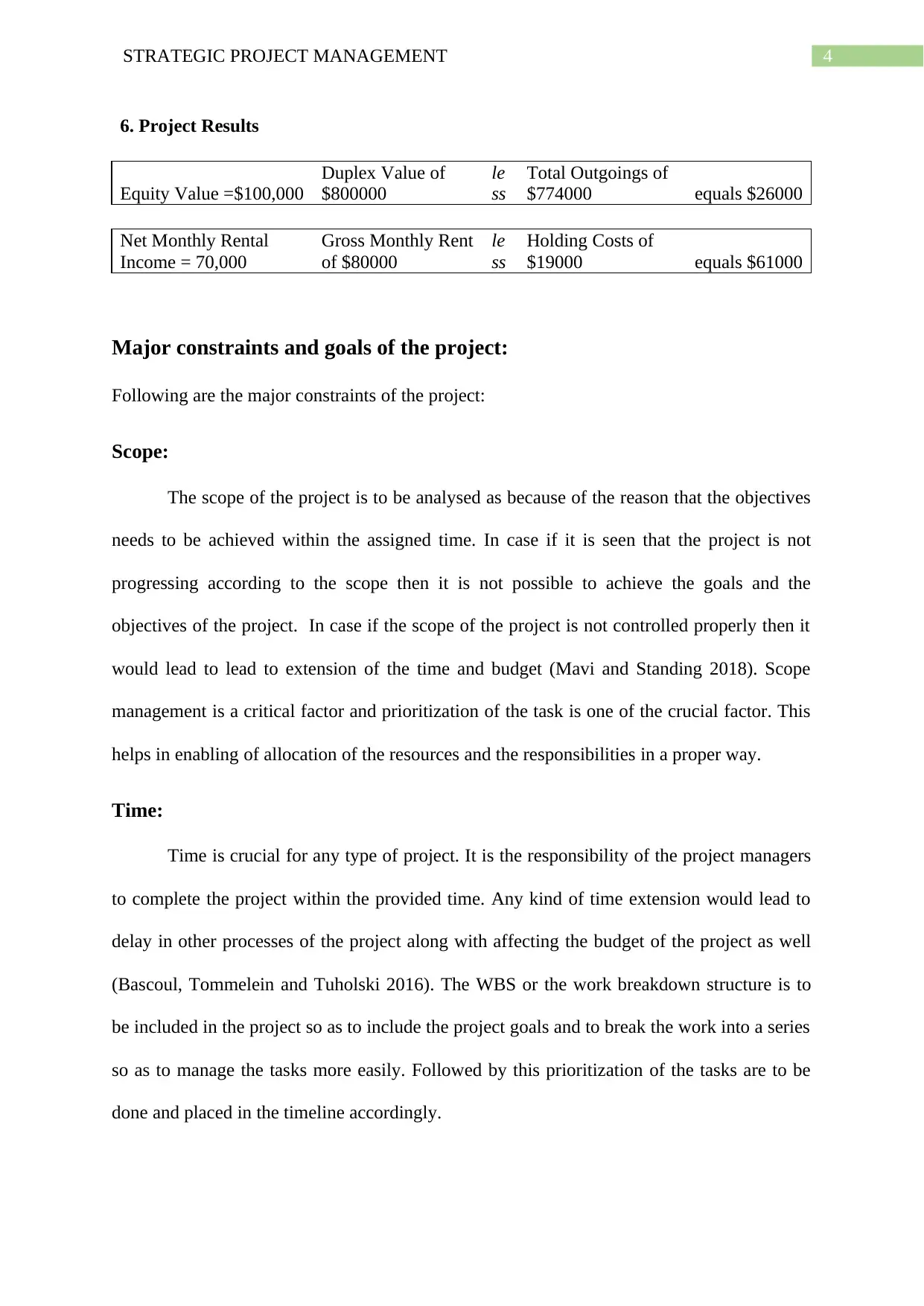
4STRATEGIC PROJECT MANAGEMENT
6. Project Results
Equity Value =$100,000
Duplex Value of
$800000
le
ss
Total Outgoings of
$774000 equals $26000
Net Monthly Rental
Income = 70,000
Gross Monthly Rent
of $80000
le
ss
Holding Costs of
$19000 equals $61000
Major constraints and goals of the project:
Following are the major constraints of the project:
Scope:
The scope of the project is to be analysed as because of the reason that the objectives
needs to be achieved within the assigned time. In case if it is seen that the project is not
progressing according to the scope then it is not possible to achieve the goals and the
objectives of the project. In case if the scope of the project is not controlled properly then it
would lead to lead to extension of the time and budget (Mavi and Standing 2018). Scope
management is a critical factor and prioritization of the task is one of the crucial factor. This
helps in enabling of allocation of the resources and the responsibilities in a proper way.
Time:
Time is crucial for any type of project. It is the responsibility of the project managers
to complete the project within the provided time. Any kind of time extension would lead to
delay in other processes of the project along with affecting the budget of the project as well
(Bascoul, Tommelein and Tuholski 2016). The WBS or the work breakdown structure is to
be included in the project so as to include the project goals and to break the work into a series
so as to manage the tasks more easily. Followed by this prioritization of the tasks are to be
done and placed in the timeline accordingly.
6. Project Results
Equity Value =$100,000
Duplex Value of
$800000
le
ss
Total Outgoings of
$774000 equals $26000
Net Monthly Rental
Income = 70,000
Gross Monthly Rent
of $80000
le
ss
Holding Costs of
$19000 equals $61000
Major constraints and goals of the project:
Following are the major constraints of the project:
Scope:
The scope of the project is to be analysed as because of the reason that the objectives
needs to be achieved within the assigned time. In case if it is seen that the project is not
progressing according to the scope then it is not possible to achieve the goals and the
objectives of the project. In case if the scope of the project is not controlled properly then it
would lead to lead to extension of the time and budget (Mavi and Standing 2018). Scope
management is a critical factor and prioritization of the task is one of the crucial factor. This
helps in enabling of allocation of the resources and the responsibilities in a proper way.
Time:
Time is crucial for any type of project. It is the responsibility of the project managers
to complete the project within the provided time. Any kind of time extension would lead to
delay in other processes of the project along with affecting the budget of the project as well
(Bascoul, Tommelein and Tuholski 2016). The WBS or the work breakdown structure is to
be included in the project so as to include the project goals and to break the work into a series
so as to manage the tasks more easily. Followed by this prioritization of the tasks are to be
done and placed in the timeline accordingly.
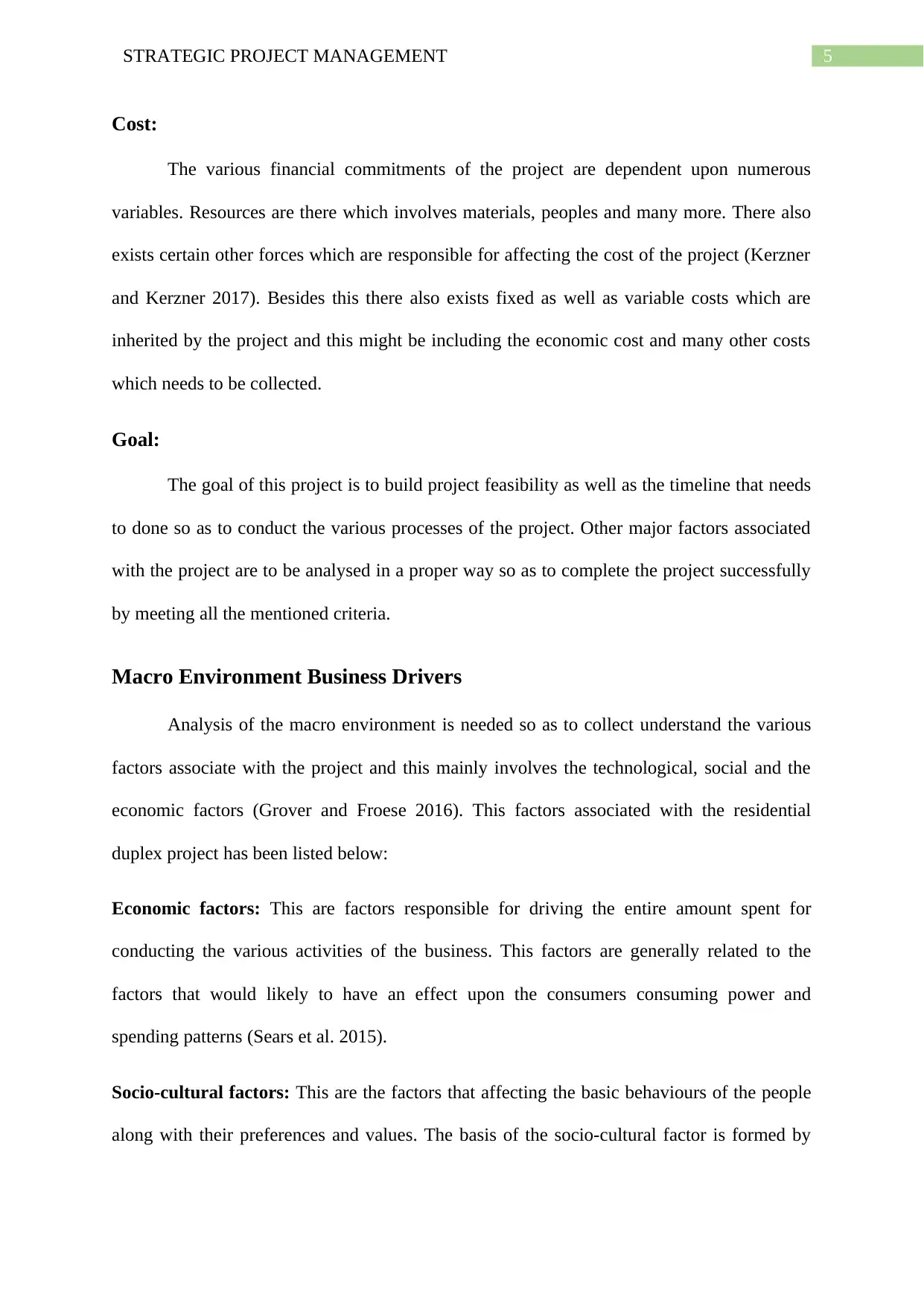
5STRATEGIC PROJECT MANAGEMENT
Cost:
The various financial commitments of the project are dependent upon numerous
variables. Resources are there which involves materials, peoples and many more. There also
exists certain other forces which are responsible for affecting the cost of the project (Kerzner
and Kerzner 2017). Besides this there also exists fixed as well as variable costs which are
inherited by the project and this might be including the economic cost and many other costs
which needs to be collected.
Goal:
The goal of this project is to build project feasibility as well as the timeline that needs
to done so as to conduct the various processes of the project. Other major factors associated
with the project are to be analysed in a proper way so as to complete the project successfully
by meeting all the mentioned criteria.
Macro Environment Business Drivers
Analysis of the macro environment is needed so as to collect understand the various
factors associate with the project and this mainly involves the technological, social and the
economic factors (Grover and Froese 2016). This factors associated with the residential
duplex project has been listed below:
Economic factors: This are factors responsible for driving the entire amount spent for
conducting the various activities of the business. This factors are generally related to the
factors that would likely to have an effect upon the consumers consuming power and
spending patterns (Sears et al. 2015).
Socio-cultural factors: This are the factors that affecting the basic behaviours of the people
along with their preferences and values. The basis of the socio-cultural factor is formed by
Cost:
The various financial commitments of the project are dependent upon numerous
variables. Resources are there which involves materials, peoples and many more. There also
exists certain other forces which are responsible for affecting the cost of the project (Kerzner
and Kerzner 2017). Besides this there also exists fixed as well as variable costs which are
inherited by the project and this might be including the economic cost and many other costs
which needs to be collected.
Goal:
The goal of this project is to build project feasibility as well as the timeline that needs
to done so as to conduct the various processes of the project. Other major factors associated
with the project are to be analysed in a proper way so as to complete the project successfully
by meeting all the mentioned criteria.
Macro Environment Business Drivers
Analysis of the macro environment is needed so as to collect understand the various
factors associate with the project and this mainly involves the technological, social and the
economic factors (Grover and Froese 2016). This factors associated with the residential
duplex project has been listed below:
Economic factors: This are factors responsible for driving the entire amount spent for
conducting the various activities of the business. This factors are generally related to the
factors that would likely to have an effect upon the consumers consuming power and
spending patterns (Sears et al. 2015).
Socio-cultural factors: This are the factors that affecting the basic behaviours of the people
along with their preferences and values. The basis of the socio-cultural factor is formed by
⊘ This is a preview!⊘
Do you want full access?
Subscribe today to unlock all pages.

Trusted by 1+ million students worldwide
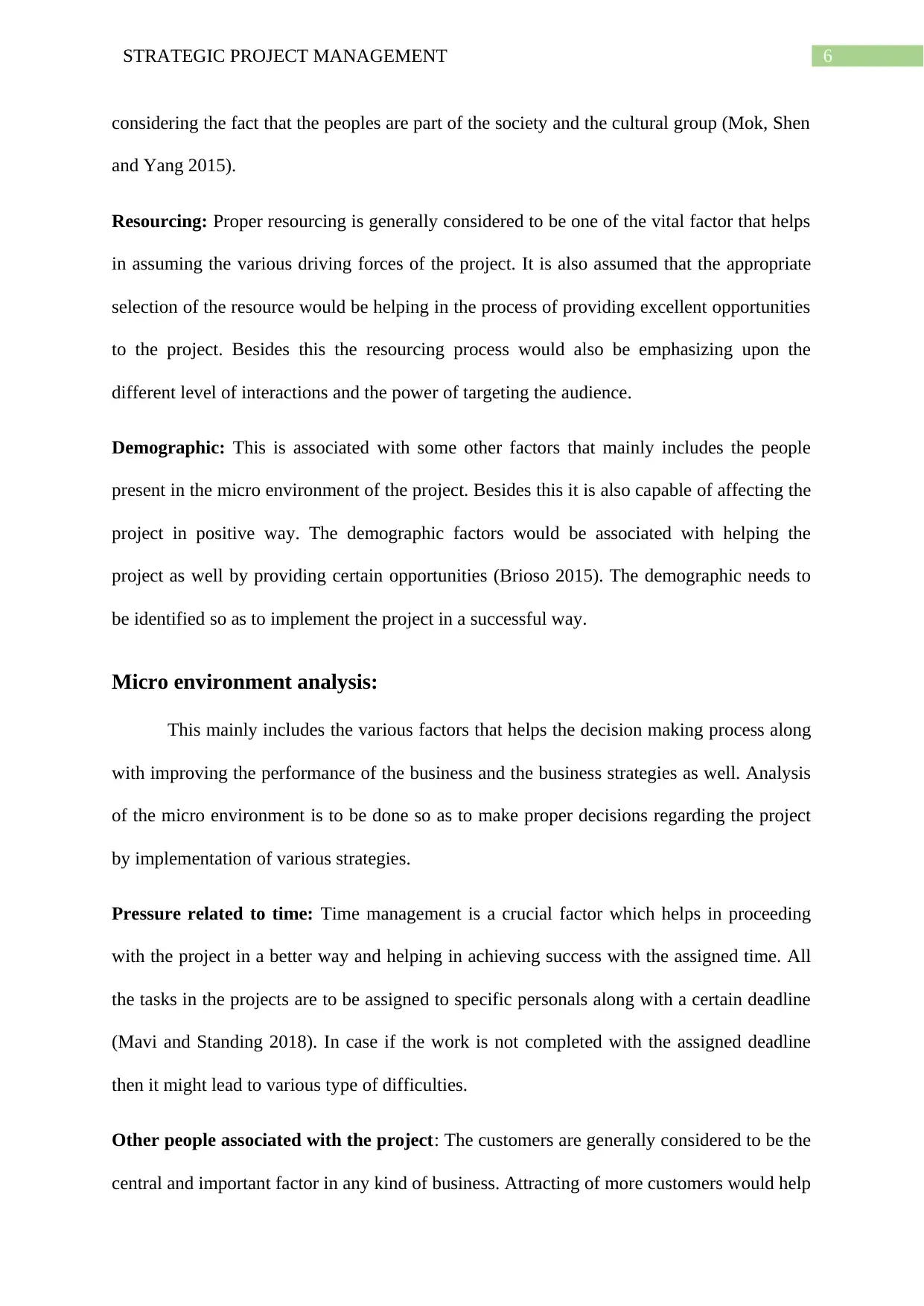
6STRATEGIC PROJECT MANAGEMENT
considering the fact that the peoples are part of the society and the cultural group (Mok, Shen
and Yang 2015).
Resourcing: Proper resourcing is generally considered to be one of the vital factor that helps
in assuming the various driving forces of the project. It is also assumed that the appropriate
selection of the resource would be helping in the process of providing excellent opportunities
to the project. Besides this the resourcing process would also be emphasizing upon the
different level of interactions and the power of targeting the audience.
Demographic: This is associated with some other factors that mainly includes the people
present in the micro environment of the project. Besides this it is also capable of affecting the
project in positive way. The demographic factors would be associated with helping the
project as well by providing certain opportunities (Brioso 2015). The demographic needs to
be identified so as to implement the project in a successful way.
Micro environment analysis:
This mainly includes the various factors that helps the decision making process along
with improving the performance of the business and the business strategies as well. Analysis
of the micro environment is to be done so as to make proper decisions regarding the project
by implementation of various strategies.
Pressure related to time: Time management is a crucial factor which helps in proceeding
with the project in a better way and helping in achieving success with the assigned time. All
the tasks in the projects are to be assigned to specific personals along with a certain deadline
(Mavi and Standing 2018). In case if the work is not completed with the assigned deadline
then it might lead to various type of difficulties.
Other people associated with the project: The customers are generally considered to be the
central and important factor in any kind of business. Attracting of more customers would help
considering the fact that the peoples are part of the society and the cultural group (Mok, Shen
and Yang 2015).
Resourcing: Proper resourcing is generally considered to be one of the vital factor that helps
in assuming the various driving forces of the project. It is also assumed that the appropriate
selection of the resource would be helping in the process of providing excellent opportunities
to the project. Besides this the resourcing process would also be emphasizing upon the
different level of interactions and the power of targeting the audience.
Demographic: This is associated with some other factors that mainly includes the people
present in the micro environment of the project. Besides this it is also capable of affecting the
project in positive way. The demographic factors would be associated with helping the
project as well by providing certain opportunities (Brioso 2015). The demographic needs to
be identified so as to implement the project in a successful way.
Micro environment analysis:
This mainly includes the various factors that helps the decision making process along
with improving the performance of the business and the business strategies as well. Analysis
of the micro environment is to be done so as to make proper decisions regarding the project
by implementation of various strategies.
Pressure related to time: Time management is a crucial factor which helps in proceeding
with the project in a better way and helping in achieving success with the assigned time. All
the tasks in the projects are to be assigned to specific personals along with a certain deadline
(Mavi and Standing 2018). In case if the work is not completed with the assigned deadline
then it might lead to various type of difficulties.
Other people associated with the project: The customers are generally considered to be the
central and important factor in any kind of business. Attracting of more customers would help
Paraphrase This Document
Need a fresh take? Get an instant paraphrase of this document with our AI Paraphraser
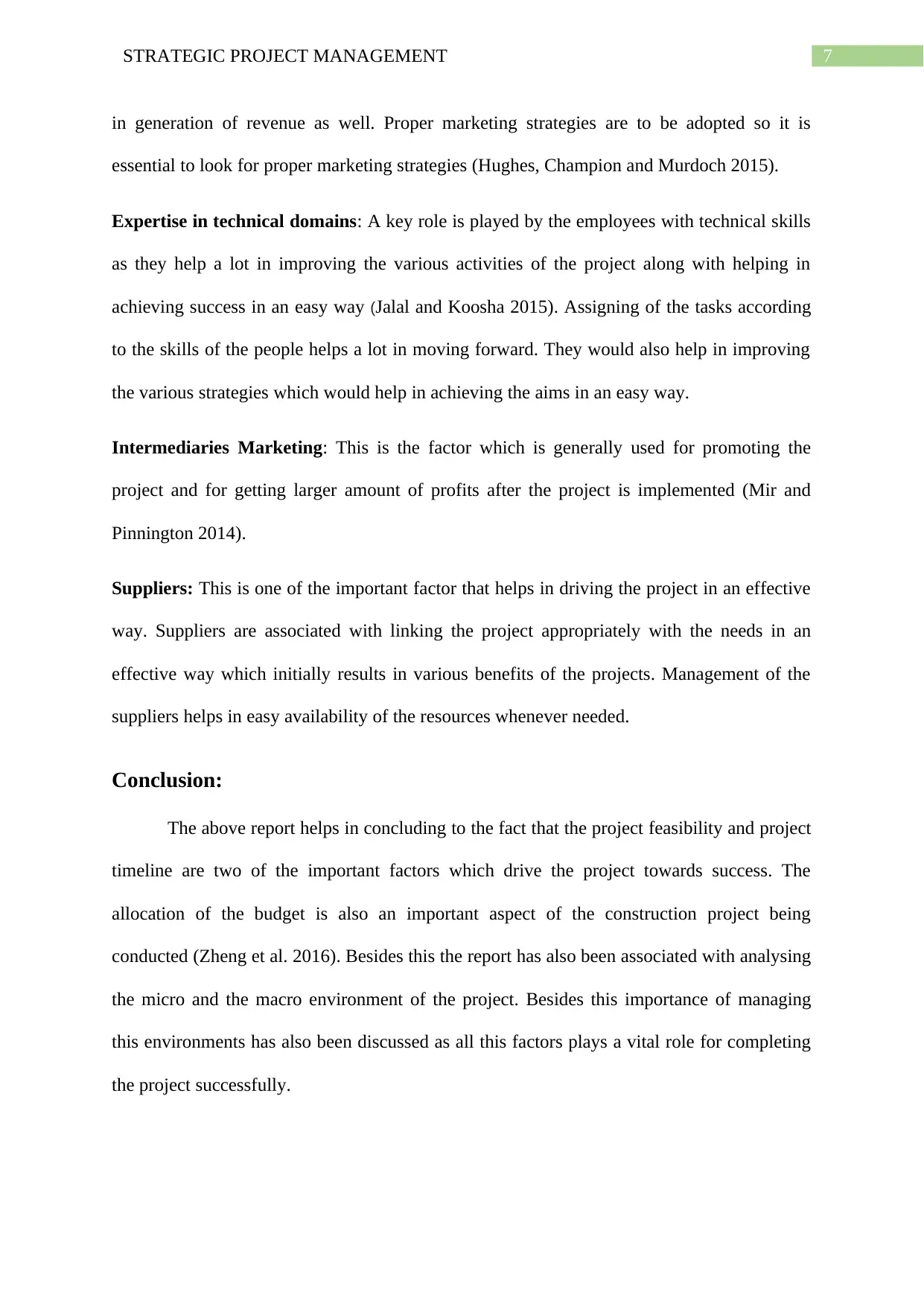
7STRATEGIC PROJECT MANAGEMENT
in generation of revenue as well. Proper marketing strategies are to be adopted so it is
essential to look for proper marketing strategies (Hughes, Champion and Murdoch 2015).
Expertise in technical domains: A key role is played by the employees with technical skills
as they help a lot in improving the various activities of the project along with helping in
achieving success in an easy way (Jalal and Koosha 2015). Assigning of the tasks according
to the skills of the people helps a lot in moving forward. They would also help in improving
the various strategies which would help in achieving the aims in an easy way.
Intermediaries Marketing: This is the factor which is generally used for promoting the
project and for getting larger amount of profits after the project is implemented (Mir and
Pinnington 2014).
Suppliers: This is one of the important factor that helps in driving the project in an effective
way. Suppliers are associated with linking the project appropriately with the needs in an
effective way which initially results in various benefits of the projects. Management of the
suppliers helps in easy availability of the resources whenever needed.
Conclusion:
The above report helps in concluding to the fact that the project feasibility and project
timeline are two of the important factors which drive the project towards success. The
allocation of the budget is also an important aspect of the construction project being
conducted (Zheng et al. 2016). Besides this the report has also been associated with analysing
the micro and the macro environment of the project. Besides this importance of managing
this environments has also been discussed as all this factors plays a vital role for completing
the project successfully.
in generation of revenue as well. Proper marketing strategies are to be adopted so it is
essential to look for proper marketing strategies (Hughes, Champion and Murdoch 2015).
Expertise in technical domains: A key role is played by the employees with technical skills
as they help a lot in improving the various activities of the project along with helping in
achieving success in an easy way (Jalal and Koosha 2015). Assigning of the tasks according
to the skills of the people helps a lot in moving forward. They would also help in improving
the various strategies which would help in achieving the aims in an easy way.
Intermediaries Marketing: This is the factor which is generally used for promoting the
project and for getting larger amount of profits after the project is implemented (Mir and
Pinnington 2014).
Suppliers: This is one of the important factor that helps in driving the project in an effective
way. Suppliers are associated with linking the project appropriately with the needs in an
effective way which initially results in various benefits of the projects. Management of the
suppliers helps in easy availability of the resources whenever needed.
Conclusion:
The above report helps in concluding to the fact that the project feasibility and project
timeline are two of the important factors which drive the project towards success. The
allocation of the budget is also an important aspect of the construction project being
conducted (Zheng et al. 2016). Besides this the report has also been associated with analysing
the micro and the macro environment of the project. Besides this importance of managing
this environments has also been discussed as all this factors plays a vital role for completing
the project successfully.
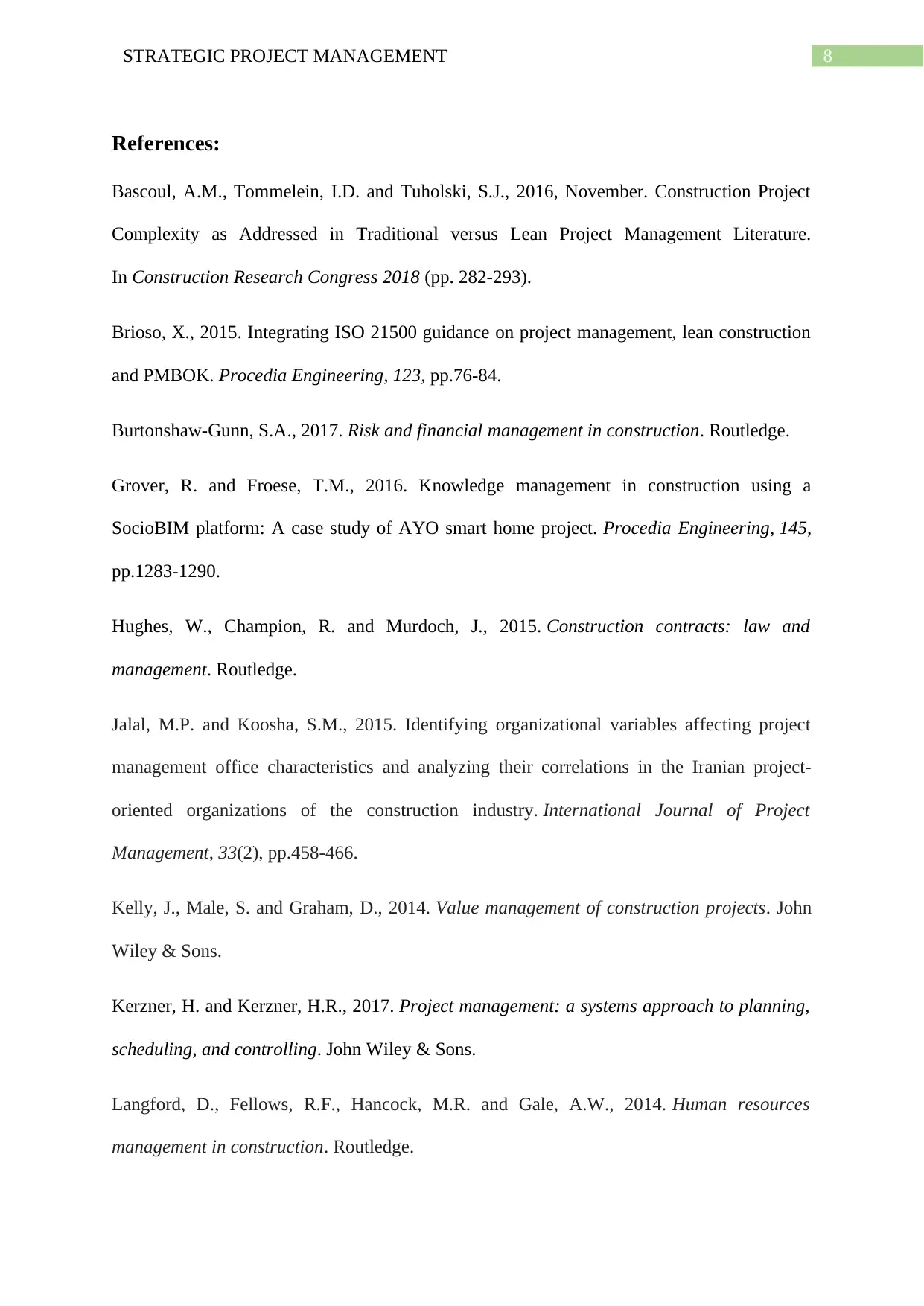
8STRATEGIC PROJECT MANAGEMENT
References:
Bascoul, A.M., Tommelein, I.D. and Tuholski, S.J., 2016, November. Construction Project
Complexity as Addressed in Traditional versus Lean Project Management Literature.
In Construction Research Congress 2018 (pp. 282-293).
Brioso, X., 2015. Integrating ISO 21500 guidance on project management, lean construction
and PMBOK. Procedia Engineering, 123, pp.76-84.
Burtonshaw-Gunn, S.A., 2017. Risk and financial management in construction. Routledge.
Grover, R. and Froese, T.M., 2016. Knowledge management in construction using a
SocioBIM platform: A case study of AYO smart home project. Procedia Engineering, 145,
pp.1283-1290.
Hughes, W., Champion, R. and Murdoch, J., 2015. Construction contracts: law and
management. Routledge.
Jalal, M.P. and Koosha, S.M., 2015. Identifying organizational variables affecting project
management office characteristics and analyzing their correlations in the Iranian project-
oriented organizations of the construction industry. International Journal of Project
Management, 33(2), pp.458-466.
Kelly, J., Male, S. and Graham, D., 2014. Value management of construction projects. John
Wiley & Sons.
Kerzner, H. and Kerzner, H.R., 2017. Project management: a systems approach to planning,
scheduling, and controlling. John Wiley & Sons.
Langford, D., Fellows, R.F., Hancock, M.R. and Gale, A.W., 2014. Human resources
management in construction. Routledge.
References:
Bascoul, A.M., Tommelein, I.D. and Tuholski, S.J., 2016, November. Construction Project
Complexity as Addressed in Traditional versus Lean Project Management Literature.
In Construction Research Congress 2018 (pp. 282-293).
Brioso, X., 2015. Integrating ISO 21500 guidance on project management, lean construction
and PMBOK. Procedia Engineering, 123, pp.76-84.
Burtonshaw-Gunn, S.A., 2017. Risk and financial management in construction. Routledge.
Grover, R. and Froese, T.M., 2016. Knowledge management in construction using a
SocioBIM platform: A case study of AYO smart home project. Procedia Engineering, 145,
pp.1283-1290.
Hughes, W., Champion, R. and Murdoch, J., 2015. Construction contracts: law and
management. Routledge.
Jalal, M.P. and Koosha, S.M., 2015. Identifying organizational variables affecting project
management office characteristics and analyzing their correlations in the Iranian project-
oriented organizations of the construction industry. International Journal of Project
Management, 33(2), pp.458-466.
Kelly, J., Male, S. and Graham, D., 2014. Value management of construction projects. John
Wiley & Sons.
Kerzner, H. and Kerzner, H.R., 2017. Project management: a systems approach to planning,
scheduling, and controlling. John Wiley & Sons.
Langford, D., Fellows, R.F., Hancock, M.R. and Gale, A.W., 2014. Human resources
management in construction. Routledge.
⊘ This is a preview!⊘
Do you want full access?
Subscribe today to unlock all pages.

Trusted by 1+ million students worldwide
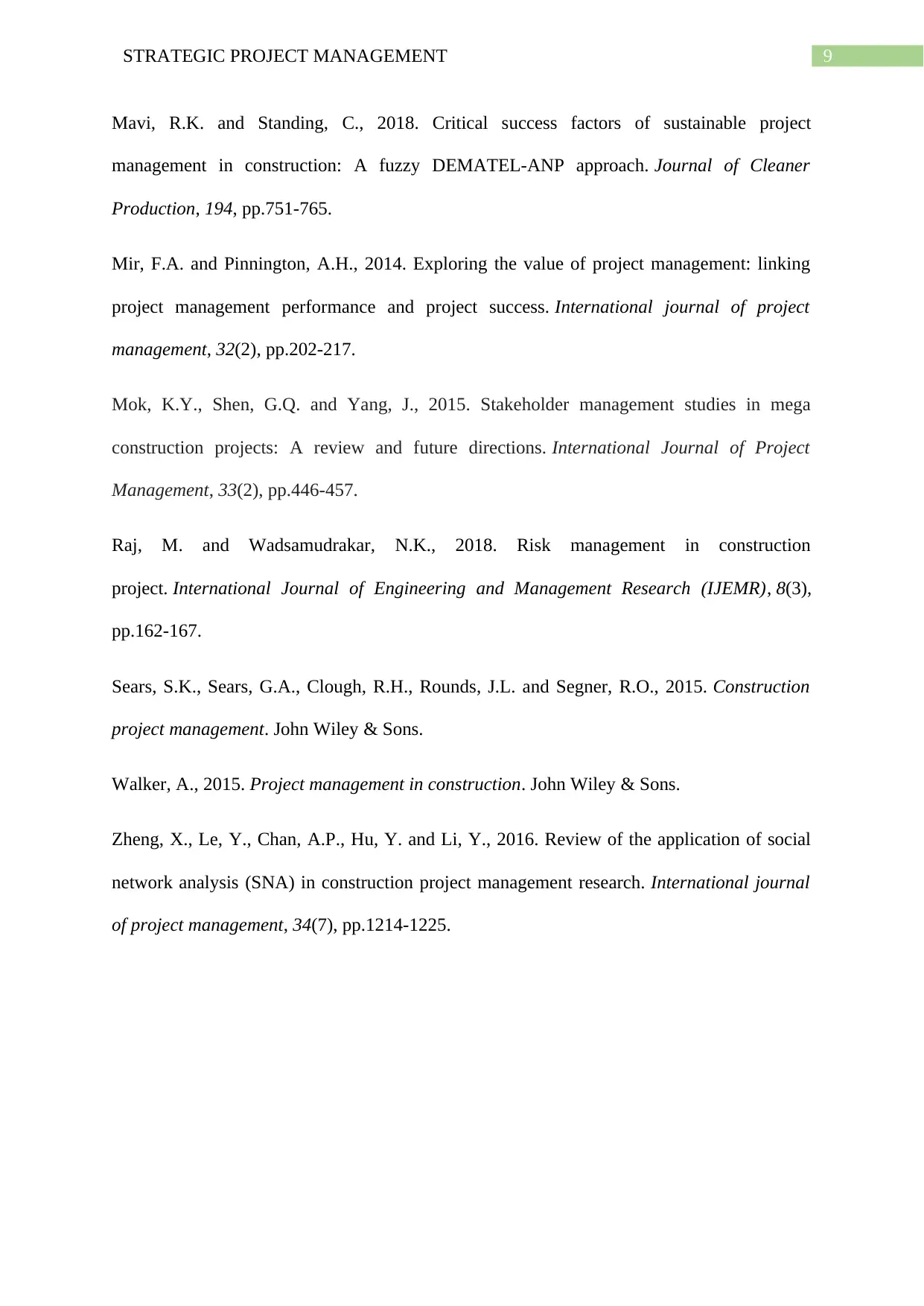
9STRATEGIC PROJECT MANAGEMENT
Mavi, R.K. and Standing, C., 2018. Critical success factors of sustainable project
management in construction: A fuzzy DEMATEL-ANP approach. Journal of Cleaner
Production, 194, pp.751-765.
Mir, F.A. and Pinnington, A.H., 2014. Exploring the value of project management: linking
project management performance and project success. International journal of project
management, 32(2), pp.202-217.
Mok, K.Y., Shen, G.Q. and Yang, J., 2015. Stakeholder management studies in mega
construction projects: A review and future directions. International Journal of Project
Management, 33(2), pp.446-457.
Raj, M. and Wadsamudrakar, N.K., 2018. Risk management in construction
project. International Journal of Engineering and Management Research (IJEMR), 8(3),
pp.162-167.
Sears, S.K., Sears, G.A., Clough, R.H., Rounds, J.L. and Segner, R.O., 2015. Construction
project management. John Wiley & Sons.
Walker, A., 2015. Project management in construction. John Wiley & Sons.
Zheng, X., Le, Y., Chan, A.P., Hu, Y. and Li, Y., 2016. Review of the application of social
network analysis (SNA) in construction project management research. International journal
of project management, 34(7), pp.1214-1225.
Mavi, R.K. and Standing, C., 2018. Critical success factors of sustainable project
management in construction: A fuzzy DEMATEL-ANP approach. Journal of Cleaner
Production, 194, pp.751-765.
Mir, F.A. and Pinnington, A.H., 2014. Exploring the value of project management: linking
project management performance and project success. International journal of project
management, 32(2), pp.202-217.
Mok, K.Y., Shen, G.Q. and Yang, J., 2015. Stakeholder management studies in mega
construction projects: A review and future directions. International Journal of Project
Management, 33(2), pp.446-457.
Raj, M. and Wadsamudrakar, N.K., 2018. Risk management in construction
project. International Journal of Engineering and Management Research (IJEMR), 8(3),
pp.162-167.
Sears, S.K., Sears, G.A., Clough, R.H., Rounds, J.L. and Segner, R.O., 2015. Construction
project management. John Wiley & Sons.
Walker, A., 2015. Project management in construction. John Wiley & Sons.
Zheng, X., Le, Y., Chan, A.P., Hu, Y. and Li, Y., 2016. Review of the application of social
network analysis (SNA) in construction project management research. International journal
of project management, 34(7), pp.1214-1225.
1 out of 10
Related Documents
Your All-in-One AI-Powered Toolkit for Academic Success.
+13062052269
info@desklib.com
Available 24*7 on WhatsApp / Email
![[object Object]](/_next/static/media/star-bottom.7253800d.svg)
Unlock your academic potential
Copyright © 2020–2025 A2Z Services. All Rights Reserved. Developed and managed by ZUCOL.





